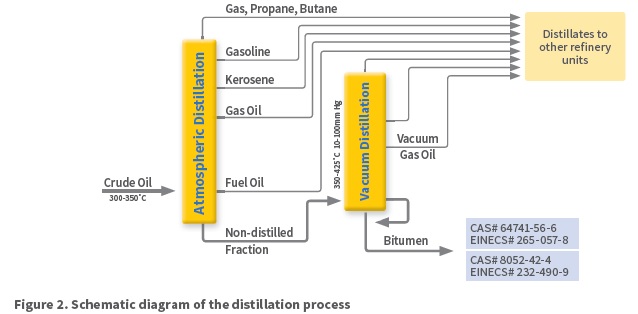
BITUMEN PRODUCTION

Bitumen production processes
Residues from the distillation of meticulously selected crude oils provide the base materials for bitumen production. Bitumen refining separates the lighter fractions from the residues. Several manufacturing methods are used to produce specification bitumen depending on the crude source and processing capabilities available. Often a combination of processes is selected. The illustration shows a compilation of the main refinery processes employed.


Of the wide variety of crude oils commercially available, only a limited number are considered suitable for producing bitumen of the required quality in commercial quantities. In general, these are heavy crude oils with high sulfur content.
Nowadays, bitumen obtained mainly from oil. There are two general ways to earn bitumen from oil.
• Distillation
• Aeration
In the first method, depends on food and way of refining, after distillation in the vacuum condition, bitumen with suitable physical characteristics for making roads and industrial applications obtained.
This process involves crude oil being heated to temperatures of between 300 and 350 degrees Celsius, to separate lighter fractions from the non-boiling component, known as an atmospheric residuum. The lighter fractions are drawn off and sent to other refinery units. To remove the last traces of the lighter fractions and avoid thermal transformation of the molecules, the atmospheric residue is then introduced into a vacuum distillation unit, where the pressure reduction lowers boiling temperatures and avoids unwanted thermal cracking of the molecules. The pressure and temperature conditions within the vacuum process determine the hardness of the residuum and, as such, the grade of bitumen produced.
Specific solvents can also be used to separate the lubricant and bitumen components of crude, without changing their chemical structure. Depending on the solvent used – propane or butane – different categories of bitumen can be obtained. By controlling the variables in the vacuum distillation process, bitumens with varying degrees of hardness can be produced. Needle penetration and softening point Ring and Ball are the two fundamental defining characteristics of bitumens produced to engineering specifications.
Bitumen can be further processed by blowing air through it at elevated temperatures to alter its physical properties for specific applications. Two different types of bitumen can be produced in this way, depending on the degree of oxidation: air rectified bitumen and oxidized bitumen. Oxidized bitumen is used in roofing applications, while air rectified bitumen is used in paving applications and some roofing applications.
In the second method, obtained vacuum residue, usually, has very low viscosity and the high degree of penetration of 300-400 mm. The product has low asphaltene, so it is not suitable for making roads in tropical and temperate regions.
Oxidized bitumen has a distinctive consistency at room temperature and a rubbery nature which affects how it responds to stress or imprint. The process of oxidation increases the stiffness and softening point of the bitumen and considerably alters key physical properties. Varying the length of the oxidation or air blowing process varies the extent of the reaction and produces distinctive end products.
To convert bitumen shaped residue to bitumen with suitable physical properties, during a process, heavy molecules like asphaltenes should be added. To do this, air that is combined with different types of gasses like oxygen, nitrogen, co2 etc been pressed by a compressor and it has been injected to a tower containing molten bitumen upper than oc200. The process can be continuous or batch. The so-called semi-aeration process causes the production of semi-blown bitumen with suitable penetration degree and softening point 100/85 or 70/60 which is used in road making and moisture barrier of houses.
If in that unit or next unit, the process of aeration being continued, gradually, penetration degree of bitumen is decreased and its softening point increases. The result is blown firm bitumen with very low penetration and so high softening point like 110/10, 90/15, 85/25. These types of bitumen are used in buildings and additives in moisture barriers.
Blending
Blending the higher and lower viscosity residues in the required proportions can take place at the refinery, at terminals or at a third party facility, where blend components and finished products can be easily transported and distributed for use.
Each processing technique results in different grades of bitumen products, including:
• Hard grade bitumens – used for paving.
• Cutback bitumens – blends of penetration bitumens with a solvent such as kerosene.
• Emulsions – stabilized suspensions of bitumen in water.
• Polymer modified bitumens – mixtures of selected bitumens with polymers, such as thermoplastics or elastomers.
